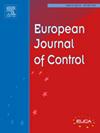具有分布延迟的数值微分器的LTI系统级联PDE-ODE观测器设计
IF 2.6
3区 计算机科学
Q2 AUTOMATION & CONTROL SYSTEMS
引用次数: 0
摘要
无传感器延迟的可观测LTI系统的不可测量状态可以通过使用状态观测器来确定,也可以直接从输入、输出及其连续时间导数中计算。数值微分固有的不适定性使得后一种方法不适用于大多数控制应用。另一方面,需要平衡收敛速率和稳态噪声抑制等设计目标对状态观测提出了重大挑战。这项工作提出了数值微分和输出误差注入相结合的系统框架,以利用这两种方法的优点。通过将无传感器延迟的LTI系统的输出导数的估计解释为附加的但延迟的输出,推导出增强系统的级联PDE-ODE公式。在这篇文章中,导数估计被当作虚构传感器的读数,用传输方程来建模。为得到的系统开发了一个观测器。我们证明了从输出导数中推断出的附加信息在可观察性格拉曼方面改善了底层系统的可观察性性质。此外,结合输出导数为设计引入了额外的自由度。我们展示了如何利用这种自由度;特别是,由于注入增益的降低,它们可以用来改善噪声衰减。对PDE-ODE级联的观测器进行了分析,并与Luenberger观测器进行了比较。实验证明了该方法的有效性。本文章由计算机程序翻译,如有差异,请以英文原文为准。
Design of cascaded PDE-ODE observers for LTI systems with numerical differentiators as fictitious sensors with distributed delay
Unmeasured states of an observable LTI system without sensor delay can be determined by use of a state observer or calculated directly from the input, the output, and their successive time derivatives. The inherent ill-posedness of numerical differentiation renders the latter approach unsuitable for most control applications. Design objectives like the need to balance convergence rates and steady-state noise suppression, on the other hand, pose significant challenges for state observation. This work proposes a systematic framework for the combination of numerical differentiation and output error injection to leverage benefits of both methods. By interpreting estimates of the output derivatives of an LTI system without sensor delay as additional, but delayed, outputs, a cascaded PDE-ODE formulation of the augmented system is derived. In it, the derivative estimates, which are treated as readings from fictitious sensors, are modeled by transport equations. An observer for the resulting system is developed. We prove that additional information inferred from output derivatives improves observability properties of the underlying system in terms of the observability Gramian. Moreover, incorporating the output derivatives introduces additional degrees of freedom to the design. We show how such degrees of freedom can be exploited; in particular, they can be used to improve noise attenuation due to a reduction of the injection gains. An analysis of the observer for the PDE-ODE cascade and a comparison to the Luenberger observer are provided. The efficacy of the proposed method is illustrated experimentally.
求助全文
通过发布文献求助,成功后即可免费获取论文全文。
去求助
来源期刊

European Journal of Control
工程技术-自动化与控制系统
CiteScore
5.80
自引率
5.90%
发文量
131
审稿时长
1 months
期刊介绍:
The European Control Association (EUCA) has among its objectives to promote the development of the discipline. Apart from the European Control Conferences, the European Journal of Control is the Association''s main channel for the dissemination of important contributions in the field.
The aim of the Journal is to publish high quality papers on the theory and practice of control and systems engineering.
The scope of the Journal will be wide and cover all aspects of the discipline including methodologies, techniques and applications.
Research in control and systems engineering is necessary to develop new concepts and tools which enhance our understanding and improve our ability to design and implement high performance control systems. Submitted papers should stress the practical motivations and relevance of their results.
The design and implementation of a successful control system requires the use of a range of techniques:
Modelling
Robustness Analysis
Identification
Optimization
Control Law Design
Numerical analysis
Fault Detection, and so on.
 求助内容:
求助内容: 应助结果提醒方式:
应助结果提醒方式:


